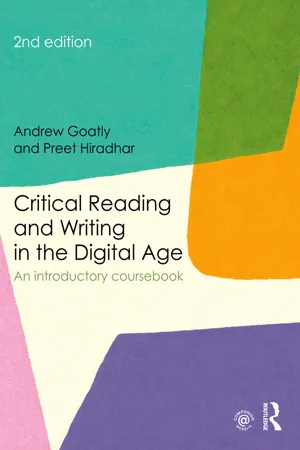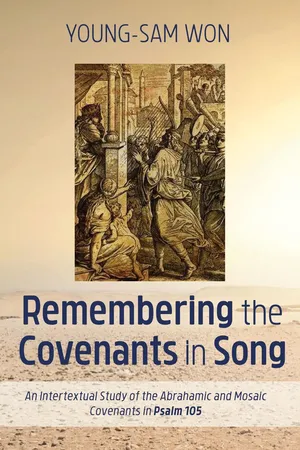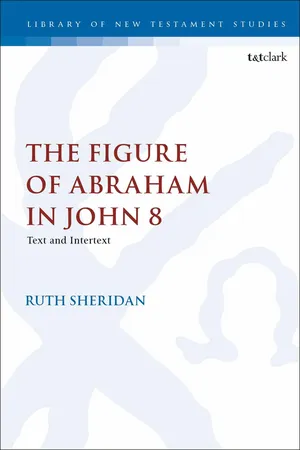Intertextuality
Intertextuality refers to the way in which texts are interconnected and influenced by other texts. It encompasses the idea that no text exists in isolation, but rather is part of a web of references, allusions, and connections to other works. Intertextuality can be seen as a dialogue between different texts, enriching the meaning and depth of literary works.
6 Key excerpts on "Intertextuality"
- eBook - ePub
Critical Reading and Writing in the Digital Age
An Introductory Coursebook
- Andrew Goatly, Preet Hiradhar(Authors)
- 2016(Publication Date)
- Routledge(Publisher)
...Intertextuality simply means the way in which one text impinges on other later texts, or, to put it another way, how texts feed off and relate to each other. But Charles Bazerman (2003) has made useful distinctions among the different levels and techniques of Intertextuality. (1) One can quote or report a text as an authority, as a source of meanings to be taken at face value, when, for example repeating a law or a proverb. (2) You may report in order to dramatise an argument, by explicitly invoking conflicting views on an issue, for example opposing views on abortion. (3) You may explicitly use other statements as background, support or contrast, as when you explain a concept by referring to an encyclopaedia entry. More implicitly, texts may (4) simply rely on common beliefs, ideas or generally circulated statements or opinions. Sometimes these will just be common knowledge – e.g. that the Earth goes round the sun, or that adolescence can be a difficult transition period in life. At other times they may be controversial but still assumed or presupposed – that competition is necessary to enhance efficiency in industry. (5) You may use specific styles or genres and the subject positions or voices associated with those genres. (6) By using any words or grammatical structures of a language you are relying on language you have acquired through the experience of hearing or reading previous texts in that language (Bazerman 2003: 86–88). We can see how these six categories might relate to the content of the first five chapters of this book. First, Intertextuality type (4) is an aspect of the inferencing we discussed in Chapter 4. The “background” or “factual” knowledge, the assumptions and schemas which we bring to texts in order to infer meanings, are largely derived from other texts...
- eBook - ePub
Researching Interpretive Talk Around Literary Narrative Texts
Shared Novel Reading
- John Gordon(Author)
- 2020(Publication Date)
- Routledge(Publisher)
...This book has already traced the influence of Bakhtin’s concepts of dialogism and heteroglossia in theories accounting for spoken interaction and in positioning theory. Bakhtin’s concepts are also relevant to Intertextuality, focussed on relationships between texts and consistent with Bakhtin’s now familiar conception of language as a chain where every utterance is ‘like the rejoinder in a dialogue’ (1986, p. 75). An adequate higher education literary pedagogy will exploit intertexuality’s capacity to foreground ‘notions of relationality, interconnectedness and interdependence in modern cultural life’ (Allen, 2000, p. 5). 8.4.1 What Is Intertextuality? Julia Kristeva (1966) is credited with introducing the term intertexuality to literary criticism, blending Bakhtin’s concepts with ideas developed by Saussure (Allen, 2000). Like dialogism, Intertextuality holds connectivity at its core: ‘the “literary word” is an intersection of textual surfaces rather than a point’ (Kristeva, 1966, pp. 64–65). Demonstrating that a text is not ‘a closed system’ (Alfaro, 1996), Lemke (1992) describes the intertexts of a text as all the other texts that we use to make sense of it. These may share ‘propositional content’ (cothematic texts), points of view (co-orienting texts), activity structure (co-actional texts) or genre (cogeneric texts). Fairclough (1992) adapts Intertextuality to Critical Discourse Analysis, presenting ‘discourse representation’ as a form of Intertextuality, where ‘parts of specific other texts are incorporated into a text’ and usually marked through reporting clauses or quotation. Fairclough also describes intertextual chains comprising verbal utterances and social practices, for example, where doctors link medical consultations and medical records: ‘social institutions and practices are articulated together in particular ways… the study of actual intertextual chains is one way of gaining insight into this dimension of social structuring’ (p. 288)...
- eBook - ePub
Remembering the Covenants in Song
An Intertextual Study of the Abrahamic and Mosaic Covenants in Psalm 105
- Young-Sam Won(Author)
- 2019(Publication Date)
- Wipf and Stock(Publisher)
...Even the post-structuralist thinkers could not fully avoid some level of dependence on literary sources and the relationships that exist between a source text and a later text. While the term Intertextuality and the technical study of the concept may be a modern pursuit in literary studies, the actual phenomenon of Intertextuality has existed as long as humanity has communicated through written texts. 343 Some of the earliest examples of Intertextuality and literary influence include the Socratic dialogues, which Bakhtin considered an early form of heteroglossia and dialogism, as well as Plato’s understanding of imitation in which every “poet” always copies an earlier work. 344 Alfaro notes that Cicero and Quintilian exhibit a developed understanding of intertextual interactions when they propose that imitation is a “consciously intertextual practice” as well as the “completion of an act of interpretation.” 345 In terms of Intertextuality in literary interpretation, one of the most significant sources of influence was the church in the Middle Ages. At a time when literature was largely tied to theology, the multi-leveled interpretation of the Bible featuring intertextual practices would influence the writing and reading of literature in the secular sphere. 346 This influence is seen in the way Renaissance literature exhibited an unprecedented awareness of the “textual past” as quotations and allusions to classical authors (e.g., Bacon and Shakespeare) demonstrate that writers believed “that their possibilities of imitation, understood as interpretation and re-writing of the Urtext, are limitless.” 347 As literary studies entered the modern era, the historical, diachronic study of sources and literary influences developed into technical methodologies...
- eBook - ePub
Echoes of Exodus
Tracing a Biblical Motif
- Bryan D. Estelle(Author)
- 2018(Publication Date)
- IVP Academic(Publisher)
...We need to recognize not only that texts interact with other texts but also that “texts have an interactive relation to cultures of various kinds.” 29 One of the benefits of studying recent trends in literary studies and particularly Intertextuality is that it forces the “scholar out into other texts and into other manifestations of culture to explore the deep-seated manifestations of foundations of which the text is a part.” 30 Such an approach forces the reader not only into other particular texts but also into traditions, customs, and cultural ideas that had a formative influence on the biblical text. 31 Furthermore, by recognizing that authors may be influenced by common cultural concepts or traditions, we are safeguarded against identifying echoes between texts as intentional or deliberate allusions; that is, two biblical texts could be alluding to a common cultural concept and not to each other. 32 Subsequent texts may be, to borrow Vincent Skemp’s language, “echo[es] within cultural intertexture.” 33 This should help us understand the complex intertexture of ideas that may be woven throughout an ancient text. 34 French structuralism, an important movement that began in the early 1900s, emphasized these kinds of complex interrelations. 35 It rejected the longstanding notion that the author had sole authority over the text, substituting instead the concept of thought in relation...
- eBook - ePub
The Figure of Abraham in John 8
Text and Intertext
- Ruth Sheridan(Author)
- 2020(Publication Date)
- T&T Clark(Publisher)
...2 Theoretical foundations: Intertextuality Introduction In his 1857 Oxford Inaugural Lecture, Matthew Arnold famously stated: ‘Everywhere there is connection, everywhere there is illustration, no single event, no single literature is adequately comprehended except in relation to other events, to other literatures.’ 1 Long before literary theorists developed what came to be termed ‘Intertextuality’, Arnold’s conception of the interrelationship between texts and events stood on the record as evidence of a growing concern among the literati of European modernity of the connectedness of life and art. 2 As readers, we grasp the interconnection of texts intuitively; as scholars of comparative literature, we possibly grasp it all the more incisively. The problem involves knowing how to reason through these interconnections, how to responsibly theorize about them and how to explain them persuasively. As we shall see in this chapter, scholars have struggled with each of these aims, and a plethora of nomenclature now exists to describe and define textual interconnections. This plethora of theoretical terms can lead not only to conceptual confusion, but also to clichéd reductions of the original meaning of terms such as ‘Intertextuality’. 3 The purpose of this chapter is to advance a theoretical grounding for the comparative analysis of texts, with a particular focus on the ancient Christian and Jewish literatures...
- Meriel Bloor, Thomas Bloor(Authors)
- 2013(Publication Date)
- Routledge(Publisher)
...In this way a new level of meaning is added to Rogers’ own presentation of his views of the world by the way in which the new author summarizes and juxtaposes major points of Rogers’ doctrine so that this religious leader appears to be intolerant, illiberal, discriminatory, and reactionary. (More of this obituary can be seen in the Activities section at the end of this chapter.) 4.4 Intertextuality in literature It has been suggested that every text carries resonances of all the texts that have preceded it, and that all discourse is the sum of past discourse. A text is also said to stand in contrast to all other texts since it reflects the specific context of its creation. This sounds somewhat mystical and unlikely at first, but it is not so strange if one thinks of how both ideas and the form of language and human interaction change and develop over the centuries. We may not always recognize the influences on the way we speak or write and, even when we do, we can only pick up on the more obvious examples. As with a family tree, the more generations one goes back from the present, the more difficult it is to identify the details. Here we will look at one literary example in some detail. A well-known example of Intertextuality from literature can be seen in Eliot’s poem The Waste Land (1922). Not only does he lift from texts of different historical periods but also from different languages: German, French, Latin and Sanskrit among others. Intertextuality is exploited by Eliot in all his poetry, but in The Waste Land, it is so intensive that Eliot was obliged to provide six pages of notes at the end of the poem to elucidate it for the readers...





